



 |
|---|
The Starter Box

A starter box is used to start grafted cells in an easy way with a minimum of time and preparations. It's convenient for the small operator or hobbyist. The box has enough space for 3 frames. 1 frame with pollen and honey on each side, and the grafted frame in the middle. If you look carefully you will see that the lid is made in such a way that the grafted frame can be inserted without taking off the whole lid. When the 2 white sheets are in place the bees can't get into the
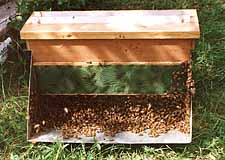 middle compartment, so it's possible to insert the frame without bees getting
out. The box is loaded with bees by shaking them onto the tin. With a little
help from the smoker they walk through the excluder into the box. Excluder
to make sure the queen isn't getting in. When there is enough bees in the
box, excluder is closed with the ventilated lid with the green mesh. When
the grafted frame is in the starter box, the white sheets are pulled out
so the bees get to the frame. The box is kept in a cool dark place until
next day when the frame goes out to a queenright hive above an excluder
to be finished.
middle compartment, so it's possible to insert the frame without bees getting
out. The box is loaded with bees by shaking them onto the tin. With a little
help from the smoker they walk through the excluder into the box. Excluder
to make sure the queen isn't getting in. When there is enough bees in the
box, excluder is closed with the ventilated lid with the green mesh. When
the grafted frame is in the starter box, the white sheets are pulled out
so the bees get to the frame. The box is kept in a cool dark place until
next day when the frame goes out to a queenright hive above an excluder
to be finished.Grafting
I am using frames with plastic cellcups. The Nicot system, similar to Jenter cellcups and holders. A larvae is transfered to the cellcup with a grafting needle.
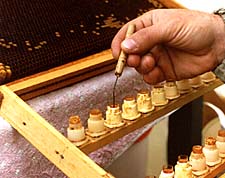 |
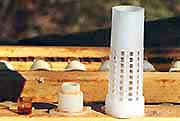 |
Cellcup, cellcup holder and the cage. |
 |
Grafting from a brood frame. | 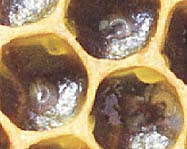 |
Larvae the right age for grafting, 4 days after the queen has laid the eggs. |
 |
Cells ready to go out to hives or to mating nucs. | 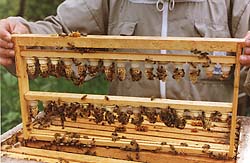 |
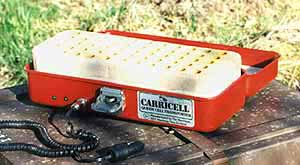
Cells are transported in the Carricell, a portable queen cell incubator. Cells are held by a foam tray that protect cells and prevent queens that emerge to attack other cells. Heat is controlled by thermostat, and it runs on 12 - 24 volts. Produced in New Zealand by John Dobson.www.carricell.com.
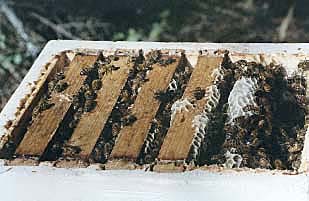
| 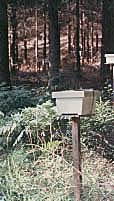
|
How to use the Starter Box
 Time required
Time requiredThe method will need approx 1 hour to produce about 25 cells. That makes 2 minutes per cell, or 8 hours totally to provide a beekeeping of 200 colonies with queens. It is possible to improve speed by producing a larger amount of cells each time, but 25 cells that hatches at the same time is enough for my needs.
 Cell builder
Cell builderI choose a hive to use for drawing out cells. Some colonies are better on making cells, I have to test to find out. The hive must be strong with many bees at an age suitable for feeding larvae. That is between 7 and 20 days old bees.
The hive consist of one or two brood boxes, excluder, and a box on top. I move two frames with young larvae and pollen from the brood area up into the top box, making sure that the queen stays in the bottom. One frame is removed from the top box, leaving an empty space between the two brood frames. The brood frames in the top box will attract nurse bees and make them go up to feed larvae. Make sure there is plenty of pollen in the top box, because the nurse bees eat pollen to be able to produce royal jelly.
 Starter Box
Starter BoxTo make a hive produce a larger number of queen cells at a time they don't really think they need them, means we have to persuade them. That's done by making them feel queenless. That's what the starter box is for, filled with worker bees and no queen. The starter box is loaded with two frames that contains honey and pollen, and an empty space for the grafted frame is left in the middle.
About one liter of bees are shaken or brushed from brood frames onto the tin of the box, and helped with some smoke to walk through the excluder into the box. When I have enough worker bees in the box, I close the ventilated lid and leave the starter box in the shade while I do the grafting. Filling the box is done at the same time I prepare the cell builder, the bees are taken from that hive.
A frame is grafted with larvae from a suitable colony, and the frame is introduced to the starter box. The sheets are pulled out of the box enabling the bees to get to the larvae in the gratfed frame. The box is then left in a cool, dark place until next day. The bees will have time to start most of the cells on the frame in one day. But if it's left longer the bees will choose only a few cells, and tear down the rest, when they realize they are too few to feed all cells on the frame.
Now when the bees have started the cells, the frame is transferred to the empty space in the top box of the cell builder hive. During the night a lot of bees have moved up to this box and filled the space where the grafted frame goes in. The bees from the starter box is poured into the top box to continue work on the grafted frame.
 Summary
SummaryDay 1: Choose a strong colony to become cell builder. Make sure the queen is beneath the excluder. Move 2 brood frames up to the box above excluder and leave space for a frame between them. Shake approx 1 liter of bees down into starter box, close hive and starter box.
Get a frame with 4 days larvae (approx 3 mm long) from breeder and graft into cell cups. Place the frame in the starter box and leave in dark and coll place over night.
Day 2: Move frame from starter box to cell builder.
Let all bees follow.
Day 10-11: Place the cells in the hives or mating nucs.
Day 12: The queens hatch.
Due to differences in temperature the queens can hatch one day earlier or later.



